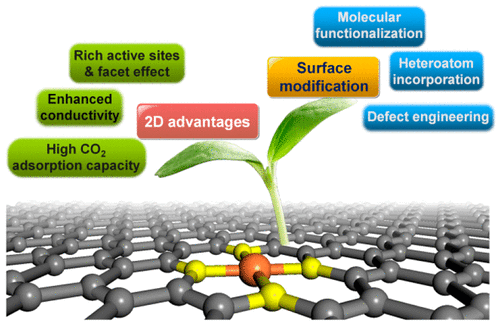当前位置:
X-MOL 学术
›
ACS Energy Lett.
›
论文详情
Our official English website, www.x-mol.net, welcomes your feedback! (Note: you will need to create a separate account there.)
Atomically Thin Two-Dimensional Solids: An Emerging Platform for CO2 Electroreduction
ACS Energy Letters ( IF 22.0 ) Pub Date : 2018-02-05 00:00:00 , DOI: 10.1021/acsenergylett.7b01343 Wentuan Bi 1 , Changzheng Wu 1 , Yi Xie 1
ACS Energy Letters ( IF 22.0 ) Pub Date : 2018-02-05 00:00:00 , DOI: 10.1021/acsenergylett.7b01343 Wentuan Bi 1 , Changzheng Wu 1 , Yi Xie 1
Affiliation

|
Benefiting from the high specific surface area and the ensuing novel electronic structures, atomically thin two-dimensional (2D) solids have drawn intense interest in the field of carbon dioxide (CO2) catalysis. Here we review the major advantages of atomically thin 2D solids for electrochemical CO2 reduction, and special emphasis will be paid to the recent advances in fine characterization and controllable tailoring of the local atomic and electronic structure. Because surface atoms in atomically thin 2D solids are comparable to the overall atoms, we highlight surface modifications, such as molecular functionalization, heteroatom incorporation, and defect engineering, as effective ways to manipulate the reactivity. Finally, the major challenges and opportunities for future development of this field are discussed. As a well-defined model system, atomically thin 2D solids offer practical possibilities to study the structure–catalytic activity relationship at the atomic level.
中文翻译:

原子薄的二维固体:CO 2电还原的新兴平台
得益于高比表面积和随之而来的新颖电子结构,原子薄的二维(2D)固体已引起了对二氧化碳(CO 2)催化领域的浓厚兴趣。在这里,我们回顾了原子薄的2D固体对于电化学CO 2的主要优点减少,并将特别强调在局部原子和电子结构的精细表征和可控剪裁方面的最新进展。因为原子薄的2D固体中的表面原子与整体原子相当,所以我们强调表面修饰(例如分子功能化,杂原子掺入和缺陷工程)是控制反应性的有效方法。最后,讨论了该领域未来发展的主要挑战和机遇。作为定义明确的模型系统,原子上薄的2D实体为研究原子级结构与催化活性之间的关系提供了实用的可能性。
更新日期:2018-02-05
中文翻译:

原子薄的二维固体:CO 2电还原的新兴平台
得益于高比表面积和随之而来的新颖电子结构,原子薄的二维(2D)固体已引起了对二氧化碳(CO 2)催化领域的浓厚兴趣。在这里,我们回顾了原子薄的2D固体对于电化学CO 2的主要优点减少,并将特别强调在局部原子和电子结构的精细表征和可控剪裁方面的最新进展。因为原子薄的2D固体中的表面原子与整体原子相当,所以我们强调表面修饰(例如分子功能化,杂原子掺入和缺陷工程)是控制反应性的有效方法。最后,讨论了该领域未来发展的主要挑战和机遇。作为定义明确的模型系统,原子上薄的2D实体为研究原子级结构与催化活性之间的关系提供了实用的可能性。



























 京公网安备 11010802027423号
京公网安备 11010802027423号